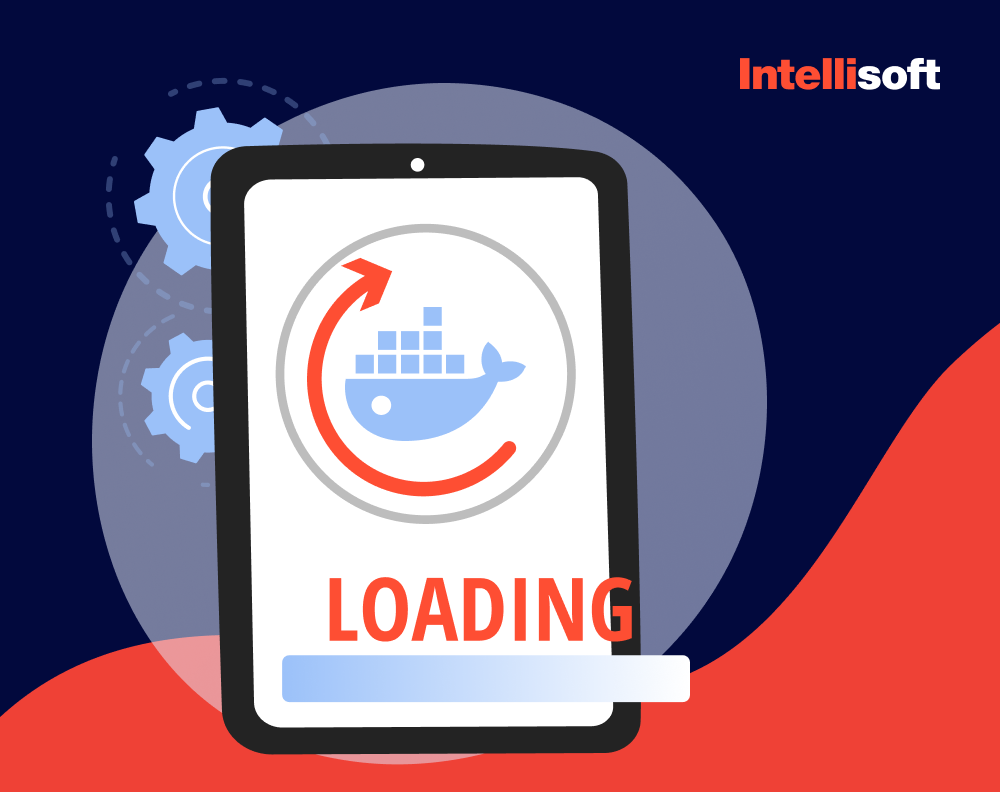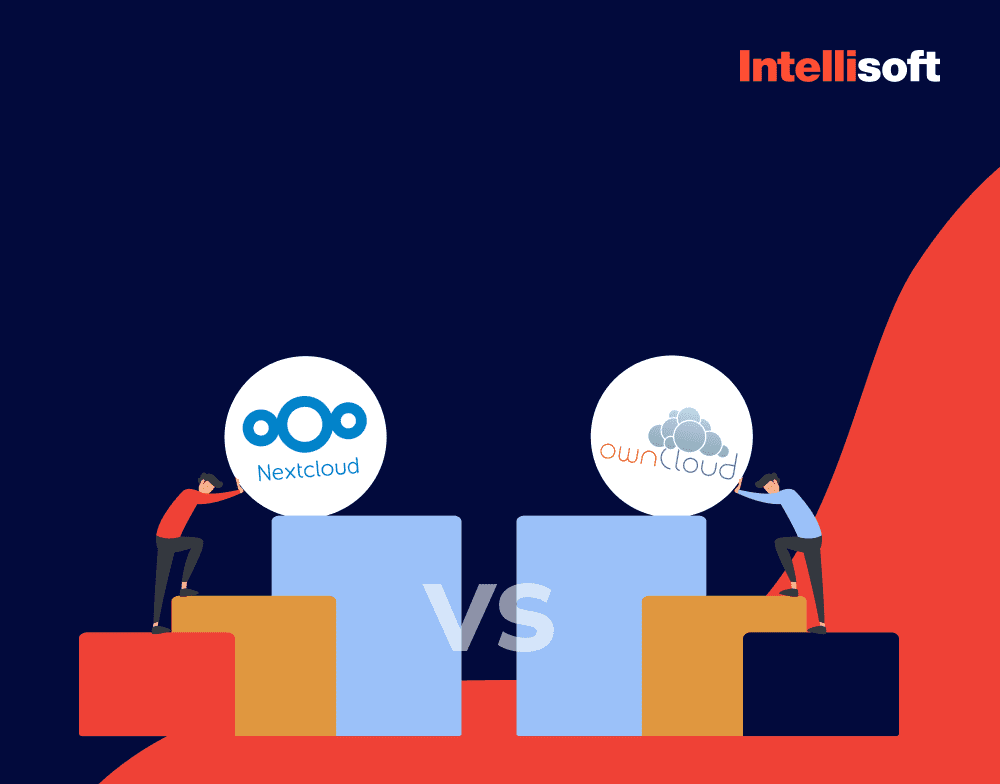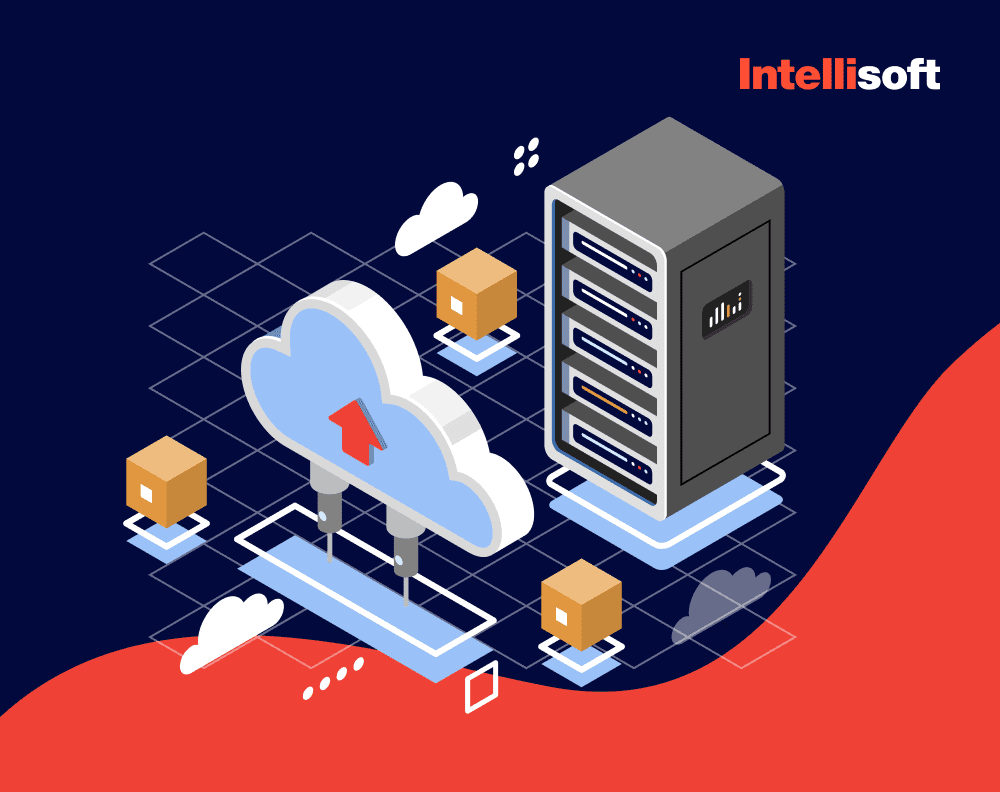The topic of container orchestration is very dynamic, and the discussion between Red Hat OpenShift vs Kubernetes influences the strategies of many technology leaders. At IntelliSoft, we excel in developing innovative solutions that harness the strengths of both platforms, giving us unique insight into this important subject. Understanding the differences between two platforms goes beyond a technical assessment – it’s about aligning these robust tools with your organization’s goals to promote innovation and efficiency.
As you explore the Kubernetes vs OpenShift landscape, it’s crucial to note that both platforms are designed to simplify the management of containerized applications. However, they each have their unique advantages and challenges. Whether you’re a startup aiming for rapid growth or an established enterprise seeking to boost operational agility, selecting the right container orchestration solution is critical. This article examines each system’s features, benefits, and drawbacks, giving you the knowledge to make the right choice.
Table of Contents
An Introduction to Container Orchestration Software
Container orchestration software is a vital part of today’s IT landscape. It automates the deployment, management, and scaling of containerized applications. This technology is key to digital transformation, allowing organizations to adapt and innovate quickly without the usual complications of application infrastructure management. By automating routine tasks, container orchestration reduces the time IT staff spend maintaining application environments, cutting overhead costs and speeding up development cycles.
The debate between Kubernetes and OpenShift mirrors other discussions such as Kubernetes vs. Docker, highlighting two leading tools in container orchestration. While OpenShift container platform vs Kubernetes share basic principles and functions, understanding their unique features and differences is crucial for technology leaders’ strategic decisions. Both platforms aim to simplify critical operations but do so in slightly different ways. These differences can greatly impact their suitability for specific business goals.
Today, we will explore the core aspects of container orchestration and closely examine Kubernetes vs. OpenShift. This discussion will provide a solid foundation for understanding how these platforms work and why they are central to discussions about efficient, scalable application deployment in the tech industry.
What is Kubernetes? The Backbone of Modern Container Orchestration
Kubernetes has transformed how organizations deploy, manage, and scale containerized applications in distributed environments. As an open-source platform, it automates extensive tasks, offering robust scaling and management capabilities that meet the dynamic demands of modern cloud and local infrastructures. This powerful tool is often called an “operating system for the cloud” and is widely adopted by major cloud service providers like Amazon Web Services, Microsoft Azure, IBM, and Google.

Key Features of Kubernetes
Kubernetes enhances application reliability and scalability through several key features:
High Availability
Kubernetes ensures applications remain available during infrastructure failures with automated failover and load-balancing capabilities.
Self-Healing
The platform monitors application health, automatically repairing and replacing failed containers to maintain system integrity.
Portability
It offers a consistent environment that supports application portability across various infrastructures, from public clouds to private data centers, helping to avoid vendor lock-in.
Extensibility
Kubernetes is highly adaptable, featuring a comprehensive API set allowing developers to create custom infrastructure and application management solutions.
These features make Kubernetes a versatile and indispensable tool for organizations looking to optimize their application operations in a containerized world.
Kubernetes Use Cases
Kubernetes excels in multiple scenarios, making it a versatile choice for various operational needs:
Large-Scale Application Deployment
The platform simplifies the deployment and management of large applications by efficiently distributing them across a server cluster.
High-Performance Computing
The platform supports environments demanding significant computational resources, facilitating tasks that require intense computational power.
AI and Machine Learning
Kubernetes efficiently runs complex AI and machine learning models by managing the necessary computing and storage resources.
Microservices Management
It provides critical services like load balancing and service discovery, which are essential for effective microservices architecture management.
Multi-Cloud and Hybrid Deployments
Kubernetes’ ability to manage applications across various cloud environments makes it ideal for hybrid and multi-cloud strategies.
Autoscaling and Automation
Features like autoscaling and automatic rollbacks ensure that applications perform optimally and reliably under different load conditions.
While Kubernetes offers extensive benefits, it also presents challenges. Its complexity can make system observability difficult, particularly in highly distributed systems. Teams must often collect extensive telemetry data to understand application performance issues fully. The need for control can complicate the rapid identification of problems and hinder scaling efforts.
Despite its complexities, Kubernetes is a powerful tool that provides substantial benefits for modern application management. Its ability to adapt to various operational requirements makes it an essential platform for businesses aiming for efficiency and innovation in their IT strategies.
What is OpenShift? Red Hat’s Enterprise Kubernetes Platform
OpenShift, developed by Red Hat, is a leading Kubernetes-based container platform that enhances Kubernetes to offer comprehensive application lifecycle management. As an open-source solution, OpenShift works seamlessly across different environments, including cloud and on-premises setups. This makes it a versatile choice for organizations using Kubernetes without the usual complexities involved in its deployment and management.

Key Features of OpenShift
OpenShift sets itself apart from standard Kubernetes offerings with a suite of integrated development tools and automated features that streamline the entire application development and deployment process:
Multi-Cloud Support
OpenShift allows organizations to deploy applications across multiple cloud environments, including public, private, and hybrid clouds, providing flexibility and scalability.
Enhanced Developer Experience
It offers built-in support for popular programming languages, frameworks, and databases, along with continuous integration/continuous deployment (CI/CD) pipelines. This creates a developer-friendly platform that simplifies workflows from development to production.
Robust Security
OpenShift incorporates extensive security measures such as role-based access control (RBAC), image scanning, and container isolation to protect applications throughout their lifecycle.
Advanced Automation
Features like automated scaling, rolling updates, and self-healing capabilities reduce the manual effort to manage applications.
These features make OpenShift a comprehensive solution that supports and enhances Kubernetes, providing a robust foundation for developing and managing containerized applications.
OpenShift Use Cases
OpenShift’s versatility makes it suitable for various applications and industries. Here are some primary use cases where OpenShift excels:
Continuous Integration and Continuous Deployment (CI/CD)
OpenShift facilitates creating and managing CI/CD pipelines, automating the software release process, and ensuring consistent and reliable application updates.
Artificial Intelligence and Machine Learning (AI/ML)
It provides a robust platform for deploying and managing AI/ML applications, handling the intensive computational demands these technologies require.
Cloud-Native Applications
Designed specifically for cloud environments, OpenShift supports developing and deploying cloud-native applications that benefit from scalability and resilience.
Application Modernization
OpenShift offers tools and capabilities to modernize applications through containerization and microservices architecture for organizations updating and enhancing legacy systems.
Databases and Data Analytics
OpenShift supports deploying scalable database and analytics applications, ensuring efficient data processing and storage capabilities.
DevOps Automation
By automating many aspects of the DevOps cycle, OpenShift streamlines workflows and improves operational efficiencies.
Hybrid and Multi-Cloud Management
OpenShift’s ability to manage applications across various cloud infrastructures makes it ideal for hybrid and multi-cloud strategies, maintaining consistency and functionality across different platforms.
While OpenShift offers many advantages, it does have limitations. As a commercial product, it is inherently less flexible than Kubernetes’s open-source nature. It primarily supports Red Hat distributions like RHEL, CentOS, and Fedora. OpenShift by Red Hat is a powerful, enterprise-ready platform that builds on Kubernetes’ strengths. It adds convenience, security, and efficiency layers critical for modern software development and deployment. This tool can be a consideration for organizations looking for broader compatibility options or those not committed to Red Hat environments.
Related readings:
- What Are Kubernetes Clusters and How to Use Them
- Docker and Microservices: The Future of Scalable and Resilient Application Development
- Monolithic vs Microservices Architecture: Pros and Cons
- Building Microservices: Top 5 Languages For Your Project
- Enterprise Cloud Computing: The Ultimate Guide
Distinguishing OpenShift from Kubernetes: A Comparative Overview
Both platforms are powerful tools for container orchestration, but they have significant differences in structure, user interface, and support mechanisms. Understanding these differences is essential for organizations to decide which platform aligns best with their operational needs and strategic goals.
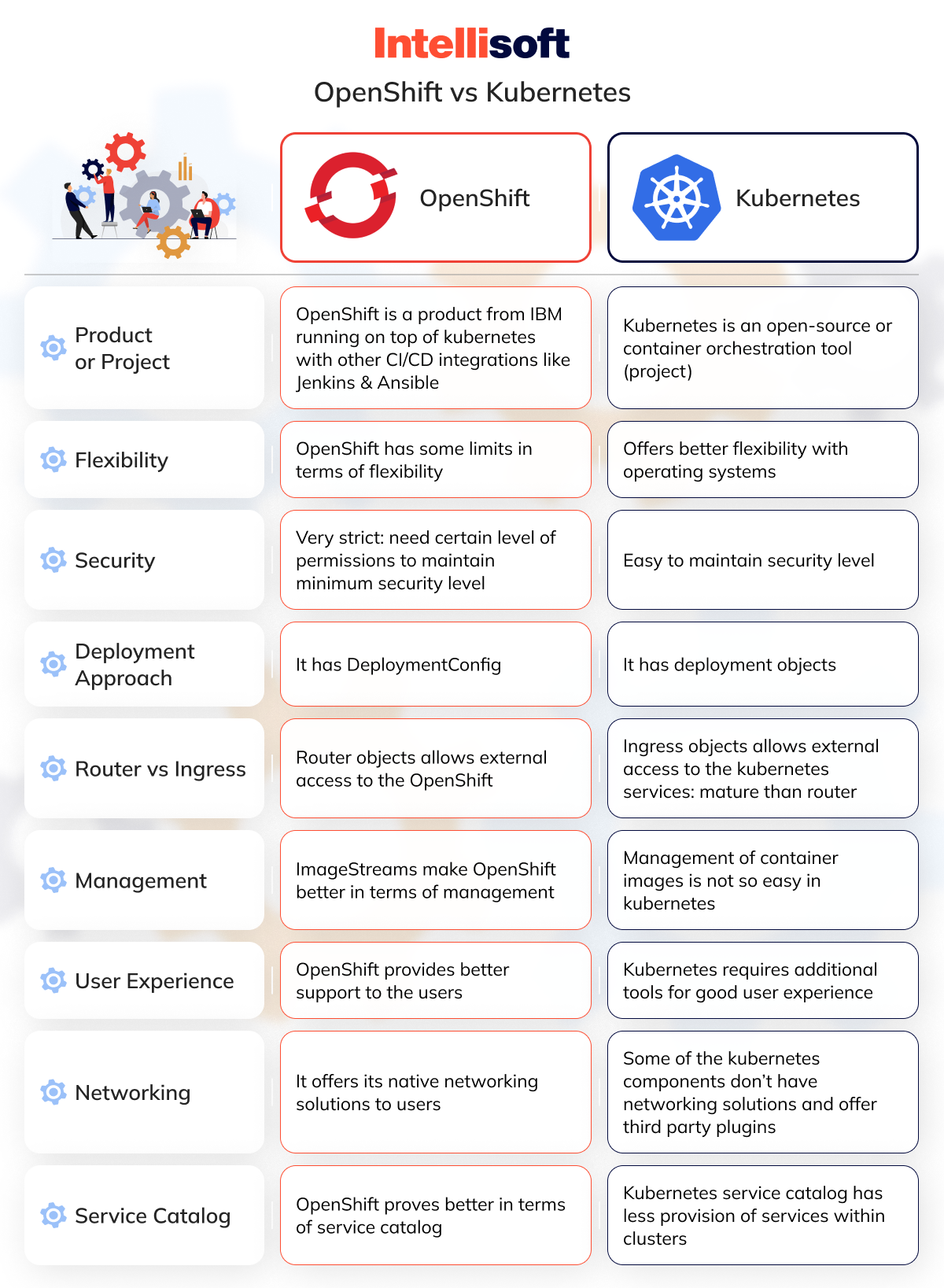
RedHat OpenShift vs Kubernetes: A Feature-by-Feature Comparison
Kubernetes is an open-source project managed by the Cloud Native Computing Foundation (CNCF). It offers a flexible foundation for container orchestration without native integration of additional tools. In contrast, OpenShift, developed by Red Hat, is a commercial product that builds on Kubernetes’ capabilities. It integrates additional features, tools, and support, making it a comprehensive enterprise solution.
User Interface and Experience
Kubernetes relies mainly on a command-line interface, which, while powerful, can be challenging to learn. OpenShift improves the user experience with a sophisticated web console with an integrated development environment and advanced monitoring tools. This greatly simplifies the management and operation of containerized applications.
Ease of Use
OpenShift stands out for its focus on simplifying the entire application deployment lifecycle. It automates many processes that Kubernetes handles manually, such as updates and scaling operations. This automation extends to security patches and system monitoring, requiring more hands-on Kubernetes management.
Security and Compliance
Security is another area where OpenShift excels. It includes out-of-the-box security features like SELinux enforcement in a multi-tenant architecture, providing robust isolation and preventing unauthorized container interactions. Kubernetes offers basic security features but requires additional configurations to meet enterprise security standards.
Integration and Support
As a Red Hat product, OpenShift benefits from seamless integration with other Red Hat offerings and comprehensive enterprise support. This ensures that OpenShift receives the latest updates and security patches directly from Red Hat, particularly useful for enterprises needing reliable technical support. Kubernetes, while well-supported, relies on community-driven solutions and third-party services for similar levels of support.
Tool Integration and Additional Features
OpenShift has built-in tools for continuous integration and deployment (CI/CD), monitoring, and logging, which are essential for modern DevOps practices. It also includes its integrated image registry, enhancing its capabilities for image management right out of the box. Kubernetes supports these functionalities but often requires manual integration and setup, which can be resource-intensive.
Deployment Environments
OpenShift’s architecture is tailored to support hybrid and multi-cloud environments more natively than Kubernetes. It offers enhanced features that simplify deploying and managing applications across various cloud platforms, aligning with businesses looking for flexible and scalable multi-cloud strategies.
While both platforms are robust solutions for managing containerized applications, OpenShift provides a more integrated, secure, and user-friendly environment. This makes OpenShift an attractive option for organizations looking for an out-of-the-box solution that reduces the complexity of managing container ecosystems.
Comparing Docker vs Kubernetes vs OpenShift: A Threefold Analysis
Understanding the relationship and differences between Docker vs Kubernetes vs OpenShift is crucial for any organization deciding on the right containerization and orchestration solutions to meet its specific needs. Each technology in the OpenShift vs Kubernetes vs Docker formula plays a unique role in developing and deploying applications, but they also intersect in ways that can enhance or complicate your infrastructure decisions.
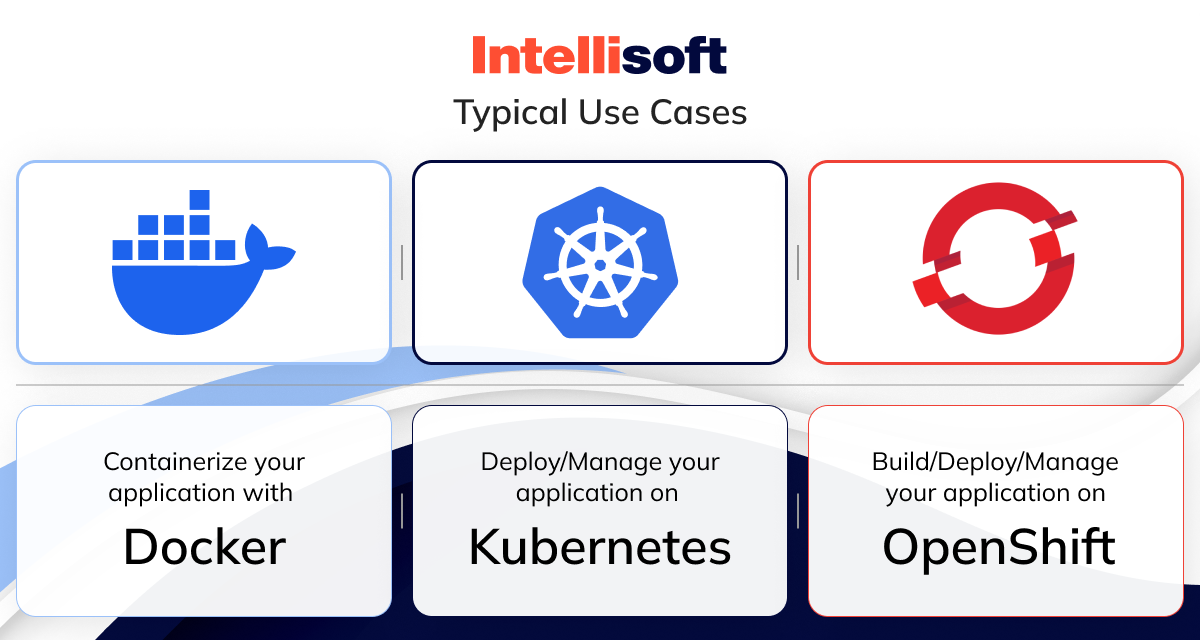
Docker: The Building Block of Containerization
It’s not easy to compare Docker swarm vs Kubernetes vs OpenShift. Docker is a platform and tool for building, distributing, and running containers. It offers a lightweight, standalone package of software that includes everything needed to run it: code, runtime, system tools, libraries, and settings. Docker is pivotal in the shift towards containerization, as it allows developers to package an application with all its dependencies into a standardized unit for software development.
Kubernetes: The Orchestrator
While Docker focuses on creating and running containers, Kubernetes is about managing them effectively after they have been created by Docker or another container runtime. Designed by Google and now maintained by the Cloud Native Computing Foundation, Kubernetes automates the deployment, scaling, and management of containerized applications. It groups containers that make up an application into logical units for easy management and discovery.
OpenShift: The Enterprise-Ready Platform
Now let’s talk about the final element of the OpenShift vs Docker vs Kubernetes formula. OpenShift, developed by Red Hat, is a cloud-based container platform that provides a more secure, enterprise-grade environment than Kubernetes alone. It integrates with Kubernetes and extends its capabilities with additional features such as multi-tenancy, extensive security, and a user-friendly interface. OpenShift also incorporates DevOps tools to support modern CI/CD methodologies that streamline the transition from development to production.
OpenShift vs Kubernetes vs Docker
While Docker and Kubernetes can be used together, where Docker provides the containerization framework and Kubernetes the orchestration capability, OpenShift includes both functions and builds upon them with additional security, automation, and developer tools. Here’s how they compare:
Integration and Ease of Use
Docker is straightforward and integrates seamlessly into many existing workflows, especially in development environments. As an orchestration tool, Kubernetes is more complex and can integrate with Docker, but it requires more setup and maintenance. OpenShift provides an integrated environment that simplifies many Kubernetes complexities.
Security
Docker offers basic security for its containers but lacks the robust, built-in security features of OpenShift. Kubernetes has configurable security features, but these require additional setup and maintenance. OpenShift provides comprehensive security out-of-the-box, including SELinux, a secure container registry, and automatic security patches.
Community and Support
Docker and Kubernetes have large, active communities and broad industry support. OpenShift, as a commercial product, offers official support from Red Hat, which can be a significant advantage for enterprises needing guaranteed uptime and security compliance.
Suitability
Docker is ideal for developers wanting to containerize their applications quickly and efficiently. Kubernetes suits operations teams who need to manage complex, large-scale container setups. OpenShift is best for organizations requiring an enterprise-grade platform that simplifies containerization and orchestration while offering enhanced security features and official support.
In summary, Docker lays the groundwork for containerization, Kubernetes orchestrates these containers effectively, and OpenShift provides an enterprise-ready platform that enhances Kubernetes’ capabilities with additional security measures and development tools. Choosing between Docker vs OpenShift vs Kubernetes depends on your organization’s specific scalability, security, support, and budget needs.
Choosing the Right Container Orchestration Platform: OpenShift vs. Kubernetes
Deciding between two platforms for your container orchestration needs involves considering several key factors, including your organization’s specific requirements, existing infrastructure, and long-term IT strategy. Each platform has strengths and may be better suited to different types of enterprises and operational models.
When to Choose OpenShift
OpenShift is ideal for organizations prioritizing robust security and enterprise-level support. Its secure-by-default approach and stringent security policies provide an added layer of protection out of the box. This is essential for industries governed by strict compliance and regulatory standards. For businesses in healthcare, finance, or government sectors, where compliance with regulations like GDPR or HIPAA is mandatory, OpenShift offers a comprehensive solution that mitigates risks associated with data privacy and security.
Besides, if your organization’s development lifecycle relies heavily on continuous integration and deployment (CI/CD), OpenShift’s integrated tooling and automated processes can significantly streamline these operations. This integration is particularly beneficial for teams looking to accelerate their development cycles while maintaining high standards of quality and reliability.
When to Opt for Kubernetes
On the other hand, Kubernetes may be more appropriate for organizations that value flexibility and extensive customization over out-of-the-box solutions. If your IT team includes in-house Kubernetes experts, you can tailor the orchestration to your precise needs and handle any issues that arise with more autonomy. Kubernetes’ open-source nature allows for deep customizations and integrations, which is perfect for tech-savvy teams that want to experiment and innovate continuously.
Additionally, the platform supports a broader range of operating systems and infrastructures than OpenShift. This makes it a suitable option for companies such as social media platforms or gaming companies, where the ability to deploy frequent updates and scale rapidly can provide a competitive edge in fast-moving industries.
Ultimately, the choice between OpenShift and Kubernetes should align with your organization’s needs, technical capabilities, and strategic objectives. If your priority is having a secure, supported, and compliance-ready platform with less need for extensive customization, OpenShift is the way to go. However, Kubernetes offers the flexibility and wide support necessary to maximize your operational effectiveness if you require a highly customizable environment and have the expertise to manage it.
Both platforms are powerful tools for managing containerized applications, but they cater to different organizational needs and priorities. By carefully assessing these factors, you can choose the platform that fits your current requirements and supports your future growth and innovation strategies.
Conclusion
Kubernetes has become a fundamental tool in container orchestration, enabling the effective management of large-scale containerized applications. It powers numerous modern software solutions, allowing businesses to manage applications across diverse environments, from on-premises data centers to public clouds and edge locations. However, Kubernetes’ raw power often requires additional layers to reach its full potential in enterprise settings.
Red Hat OpenShift builds on Kubernetes by offering a comprehensive container application platform that includes everything needed for development, deployment, and management at scale. OpenShift not only provides a stable Kubernetes engine but also enhances it with robust security features and a variety of integrated capabilities. These additions are crucial for businesses that need a reliable, secure, and efficient platform to manage their entire software lifecycle across different environments.
At IntelliSoft, we understand the vital role effective container orchestration plays in digital transformation and operational efficiency. Whether you choose Kubernetes for its flexibility and broad support or OpenShift for its comprehensive enterprise-ready features, IntelliSoft can guide you through your orchestration journey. Our experts specialize in Kubernetes and OpenShift, providing tailored solutions that align with your business needs and technical requirements.
We offer consultancy and implementation services to help you deploy these powerful tools effectively. Partner with us to leverage our deep industry knowledge and technical expertise in container orchestration. Let us help you simplify the complexities of modern software management so you can focus on what matters most – growing your business and delivering exceptional value to your customers. Contact us today, and together, we’ll unlock the full potential of your software infrastructure.


